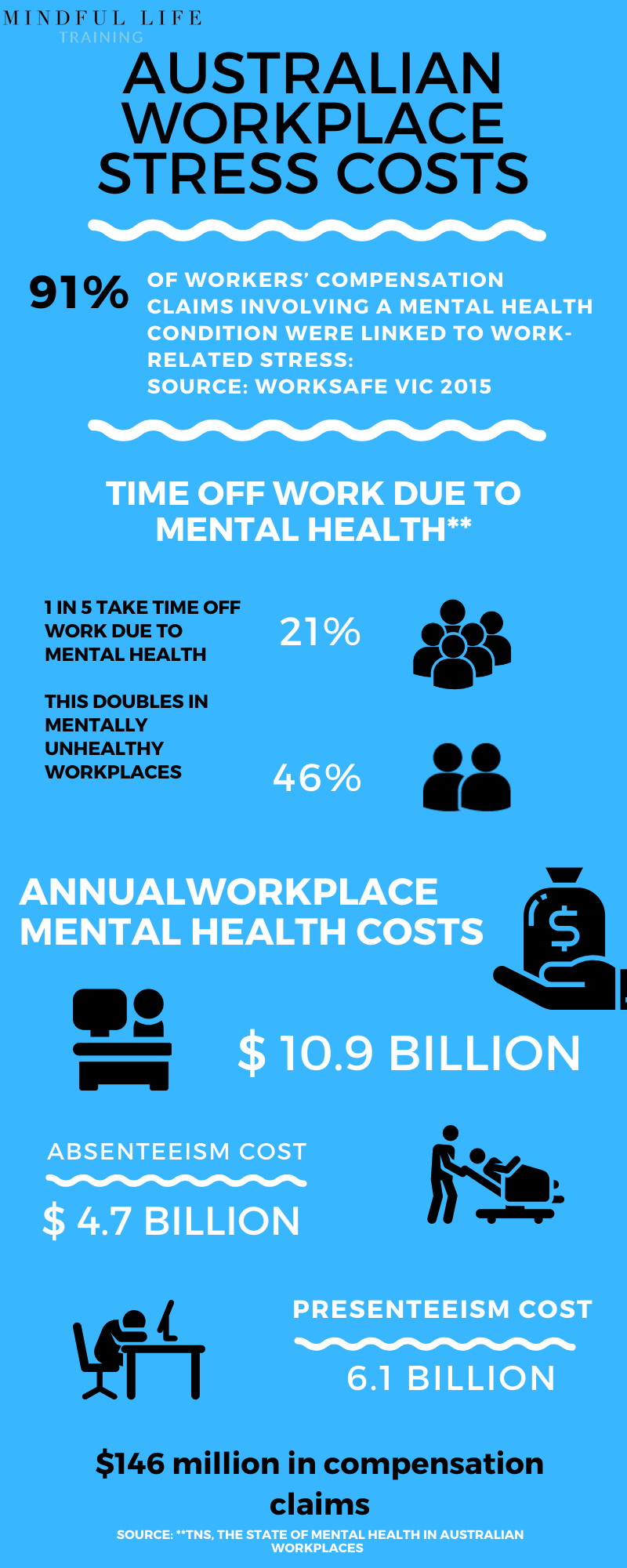Kate has been promoted this year to a mid-level executive role in a fast-paced Australian technology firm, Corporation EX. The culture is high energy, high tech, innovation and achievement driven. Kate is responsible for her own targets and her teams.
Recently, the firm has restructured which means Kate’s team need to accomplish different targets with fewer resources in a new way. Kate tries to eat well and exercise. However, with so many changes, any time she had for herself has disappeared.
Kate has been feeling overwhelmed since her promotion, with little organisational support. She has been feeling more ambiguous, making more mistakes and has been suffering from anxiety. In addition, she has had increasingly poor gastrointestinal health, unrefreshing sleep and running on adrenaline. She has little energy and a job that used to inspire her is gradually making her physically and psychologically unwell.
Kate is suffering from workplace stress and a very well researched syndrome known as burnout.
Myth 1: Everyone gets stressed from time to time, it’s up to the individual to manage it.
Whilst its true, most people suffer periods of overwhelm and stress in their work lives and a certain level of positive stress is necessary for motivation and performance. Ongoing, though, structural workplace stress like Kate is experiencing can cause ill-health and burnout.
Burnoutis a serious and well researched workplace stress syndrome. Burnout is a syndrome that results from chronic stress at work, with serious consequences to workers’ well-being and health including physical illness and psychological impacts.
A 2017 Meta-analysis of 36 high quality research studies revealed the consequences of workplace burnout as the physical illnesses of Type 2 diabetes, Coronary heart disease, prolonged fatigue, headaches, gastrointestinal issues, respiratory problems and severe injuries. This includes, increased risk of death below 45 years of age.
Psychologically, burnout for workers caused insomnia, depressive symptoms, use of psychotropic and antidepressant medications, hospitalisation for mental disorders and psychological ill-health symptoms. In addition, job dissatisfaction, absenteeism, and presenteeism were identified as professional outcomes.

Myth 2: Stress is relative to the individual and you cannot separate stress in the workplace
Some companies question whether individual’s mental health should be ascribed to them personally and their own personal psycho-social issues. But research evidence shows a clear delineation between the types of stressors at work that are “independent” of an individual’s mental health issues.
So, the idea that stress is only present in individuals, and not caused by workplace factors alone, is an absolute myth. And unfortunately, one that has been perpetuated by organisations who are being myopic with the real data on physical, financial and socio-emotional costs of workplace stress. This is exacerbated by organisations who are in high change environments, fast growth phase and who do not have preventative health and well-being strategic plans in place.
These plans of course should be linked to the values of the organisation and in a generation defined by employees who value the “whole person” and their wellness rather than their pay packets. This will be defining factor for employer brand perception, competitive differentiation and attracting, motivating and retaining key talent.
Further, according to Worksafe Australia, (2015), around
91% of workers’ compensation claims involving a mental health condition were linked to work-related stress or mental stress.
Mental stress refers to the mechanism of injury describing work-related stress in claims data. So workplace stress and mental health are inextricably linked.
Therefore, there is a real need to address the causes and impacts of high levels of stress at work. These issues include job hours and structure, workplace bullying and harassment, physical violence, exposure to a traumatic events and sexual/racial abuse.
Recently SBS aired an investigation into Burnout on their program “Insight” (October29, 2019). Researchers estimate the syndrome could affect anywhere between 8% of workers to 60% in some industries. They explain that: “Burnout isn’t just a response to working long hours. It’s feelings of exhaustion, cynicism and a reduced sense of accomplishment, after suffering long-term job stress.”

To address workplace mental health issues and the serious and increasing issues of burnout and workplace stress is crucial for individuals and organisations in reducing suffering, anxiety and depression at work, in organisations, and carried forward into personal lives.
Mindfulness, compassion and EQ training have all been shown to have significant workplace benefits and provide employers with a strong financial and cultural return on their investment.
Some of the organisational benefits include:
✳️ Reduced insurance premiums.
✳️ Increased worker productivity and team performance
✳️ Reduced costs associated with making reasonable work adjustments.
✳️ Reduced levels of conflict, bullying harassment
✳️ Improved psychological and physical safety
✳️ Improved organisational engagement, better relationships, greater vision and creative thinking
Myth 3: Workplaces should focus the majority of their OHS expenditure on providing a physically safe work environment
According to Worksafe Victoria and other research, Australian workplaces have a far greater understanding, focus and expenditure on the physical safety of their employees when compared to psychological safety.
No-one is suggesting that workplaces should not be physically safe environments. However, the research shows psychological safety, prevention and identification of people at high risk (psychologically) is vastly underestimated.
Recently proposed new legislation in Victoria proposes bosses may face up to 20 years in jail for manslaughter charges for suicides under new workplace laws. The new legislation will apply to employers in public and private companies whose negligence resulted in a death of an employee, be that by providing a dangerous workplace or failing to provide appropriate mental support.
Current Costs in Australia of Workplace Mental Health
Mental health conditions currently cost Australian workplaces approximately $10.9 billion per year. This comprises $4.7 billion in absenteeism, $6.1 billion in presenteeism and $146 million in compensation claims.

How much is stress, burnout and mental health costing your organisation? And what types of risk reduction OHS policies do you have in place?
For further assistance in identifying, measuring and preventing stress in your workplace get in touch : [email protected] or connect with me on LinkedIn for a further conversation.
Originally Published Mindful Life Training November7, 2019.
https://www.mindfullife.com.au/blog/the-three-myths-of-workplace-stress-and-burnout-australia

